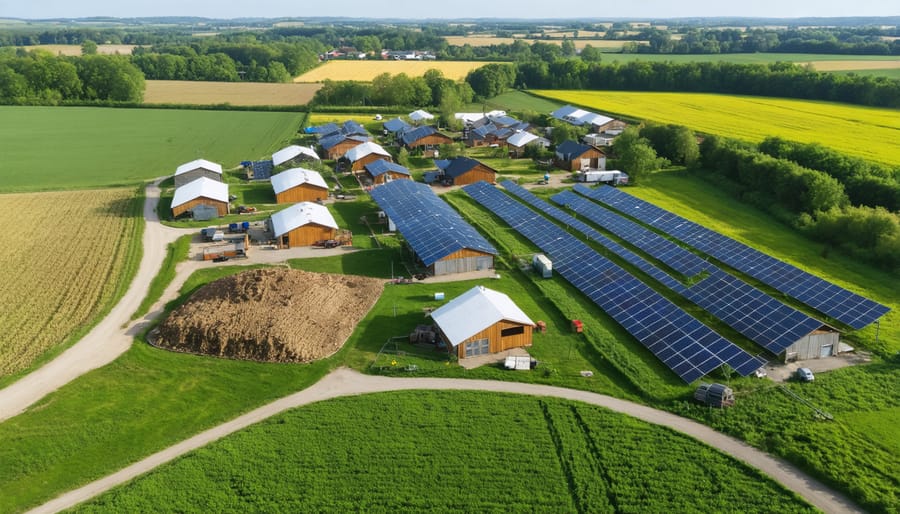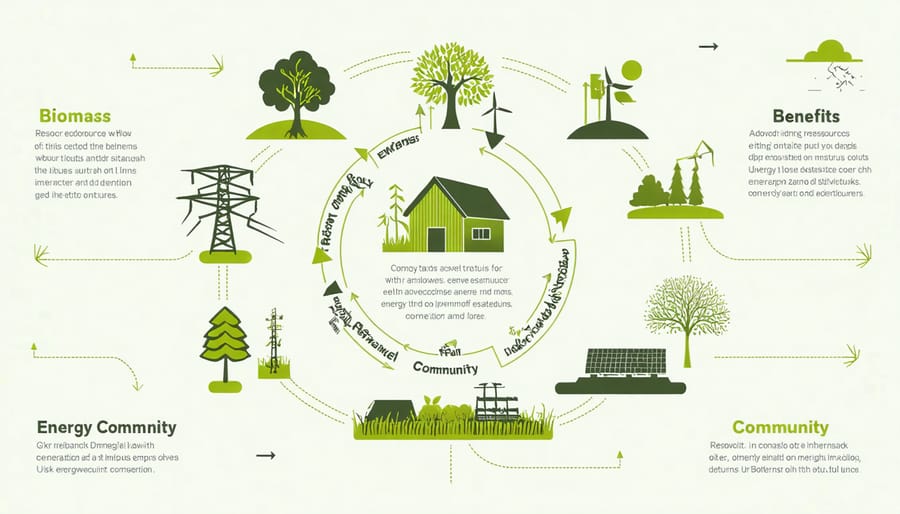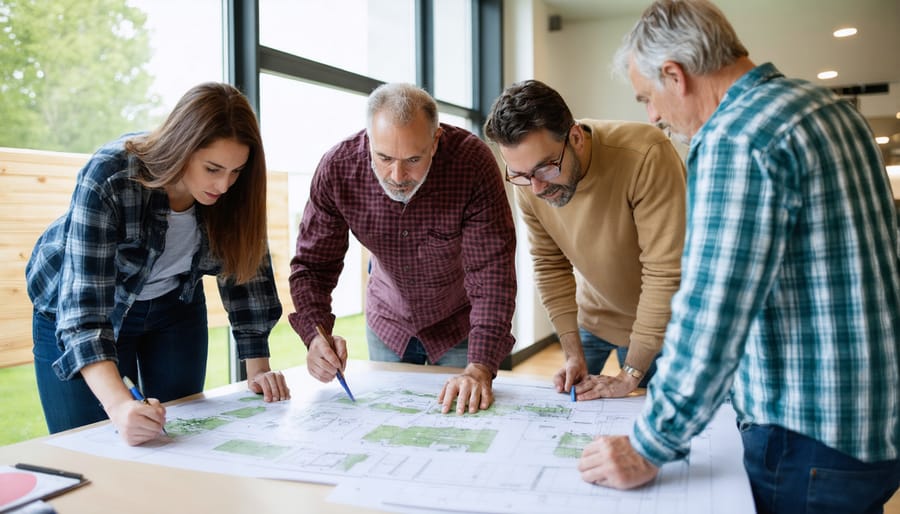Energy communities are revolutionizing how we power our neighborhoods and businesses, creating a dynamic shift from traditional energy systems to collaborative, sustainable solutions. These self-organized groups of citizens, businesses, and local organizations work together to generate, consume, and manage renewable energy, including the numerous benefits of bioenergy initiatives. Unlike conventional energy systems, energy communities empower local stakeholders to take control of their energy future, fostering environmental responsibility while building economic resilience.
In Australia, these communities are emerging as powerful catalysts for change, transforming how regions approach energy independence. From urban neighborhoods installing shared solar systems to rural communities developing bioenergy projects, these initiatives demonstrate how collective action can drive sustainable development. Energy communities represent more than just power generation—they’re about creating self-sufficient, environmentally conscious networks that benefit all participants through reduced costs, enhanced energy security, and strengthened community bonds.
Through innovative partnerships and creative solutions, energy communities are proving that sustainable energy isn’t just about technology—it’s about people working together to create lasting positive change.
What Makes an Energy Community?

Key Components of Bioenergy Communities
Successful bioenergy communities are built on several foundational elements that work together to create sustainable and effective energy systems. At the heart of these communities lies shared resource management, where members collectively maintain and benefit from bioenergy infrastructure such as biomass processing facilities or anaerobic digesters.
Collaborative decision-making forms another crucial component, ensuring all stakeholders have a voice in determining the community’s direction. This democratic approach typically involves regular meetings, transparent governance structures, and clear protocols for resolving conflicts and sharing benefits.
Local participation is essential, with community members actively engaging in various aspects of the bioenergy system. This might include farmers supplying organic waste, local businesses providing technical expertise, or residents contributing to operational decisions. The “fair dinkum” Australian approach to community involvement ensures everyone has skin in the game.
Knowledge sharing and capacity building play vital roles, with communities establishing education programs and skill-development initiatives. This helps maintain long-term sustainability and creates local employment opportunities.
Financial frameworks represent another key component, including mechanisms for shared investment, profit distribution, and risk management. Many successful communities operate through cooperative models or community-owned enterprises.
Infrastructure and technology management rounds out the essential elements, requiring systems for maintaining equipment, monitoring performance, and adapting to changing needs. This often includes partnerships with technical experts and service providers while keeping control firmly in community hands.
Legal and Organizational Structures
In Australia, energy communities can take several legal forms, each offering distinct advantages for community-driven renewable energy initiatives. The most common structure is the cooperative model, where members have equal voting rights and share in the benefits of renewable energy generation. Cooperatives are particularly popular in regional areas, offering local communities direct ownership and control over their energy resources.
Not-for-profit organizations represent another significant model, allowing communities to reinvest surplus funds into local sustainability projects. These entities often partner with local councils and receive government grants to support their initiatives.
Private companies limited by shares are increasingly common, especially for larger-scale projects. This structure provides flexibility in raising capital through share offerings while maintaining community focus through carefully crafted constitutions and shareholder agreements.
Some communities opt for hybrid models, combining elements of different structures. For example, a proprietary limited company might work alongside a community trust, ensuring both commercial viability and social benefit. These arrangements often include provisions for local investment opportunities and benefit-sharing schemes that keep resources within the community.
Each structure must comply with Australian energy regulations and corporate law while maintaining the core principles of community ownership and democratic control.
Community Benefits and Social Impact

Economic Advantages
Energy communities drive significant economic benefits for their participants and the broader local economy. One of the most immediate advantages is the substantial reduction in energy costs, with members typically saving 20-30% on their energy bills through shared renewable resources and collective purchasing power.
Job creation stands out as a major economic benefit, with energy communities fostering employment across multiple sectors. From installation and maintenance of renewable energy systems to project management and community engagement roles, these initiatives create diverse employment opportunities. In regional Australian communities, energy projects have become vital sources of skilled employment, helping to retain young professionals in rural areas.
The local economic impact extends beyond direct employment. Energy communities often partner with local businesses and contractors, creating a multiplier effect that strengthens the regional economy. Money previously spent on external energy providers stays within the community, supporting local growth and development.
Investment in energy communities also attracts additional funding and business opportunities. Many communities have successfully leveraged their initial projects to secure grants, private investment, and government support for expanded initiatives. This economic momentum has helped revitalize regional areas, with some communities establishing themselves as renewable energy hubs.
The financial benefits are particularly notable for farming communities, where reduced energy costs significantly impact operational expenses. These savings enable businesses to invest in growth, innovation, and additional sustainability measures, creating a positive cycle of economic development.
Environmental Benefits
Energy communities play a pivotal role in reducing carbon emissions and fostering environmental sustainability. When neighbours collaborate to generate and share renewable energy, they significantly decrease their collective carbon footprint compared to traditional energy consumption patterns. A typical energy community can reduce carbon emissions by 30-60% through the implementation of shared solar installations and other renewable energy sources.
These communities contribute to environmental protection through more efficient resource management. By sharing energy infrastructure and implementing smart grid technologies, they minimize energy waste and optimize consumption patterns. This collaborative approach leads to reduced strain on natural resources and helps preserve local ecosystems.
The environmental benefits extend beyond just emissions reduction. Energy communities often incorporate green spaces and sustainable landscaping into their projects, enhancing biodiversity and creating natural carbon sinks. Many Australian energy communities have successfully integrated native plant species and wildlife corridors into their renewable energy installations, demonstrating how clean energy generation can coexist with habitat preservation.
Furthermore, energy communities promote environmental awareness and education among members. This increased consciousness often leads to additional sustainable practices, such as community composting, rainwater harvesting, and waste reduction initiatives. The ripple effect of these environmental benefits extends well beyond the community’s boundaries, inspiring neighbouring areas to adopt similar practices and contributing to Australia’s broader sustainability goals.
Social Cohesion
At the heart of every successful energy community lies a strong foundation of social cohesion, where members work together towards shared environmental goals. This collective approach not only strengthens community bonds but also creates a powerful platform for sustainable change. The community impact of biomass energy projects extends far beyond renewable power generation, fostering a sense of shared purpose and environmental stewardship.
Australian communities that embrace collective energy initiatives often report increased neighbourhood engagement, with regular meetings and events bringing together diverse groups of residents who might otherwise rarely interact. These connections create valuable support networks that help sustain long-term environmental commitments and encourage broader participation in sustainability efforts.
The social fabric of energy communities is strengthened through knowledge sharing, mutual support, and collaborative decision-making. Members often become environmental advocates within their broader communities, spreading awareness about sustainable practices and inspiring others to join the movement. This ripple effect can transform entire neighbourhoods into hubs of environmental innovation and responsibility.
Local success stories demonstrate how shared ownership of renewable energy projects creates a stronger sense of community pride and achievement. When residents see tangible results from their collective efforts, it reinforces their commitment to environmental goals and encourages further sustainable initiatives.
Success Stories: Australian Bioenergy Communities
Rural Success Stories
Australia’s rural communities are leading the way in demonstrating how energy communities can transform local economies through innovative biomass utilization. In the Goulburn Valley, a cooperative of fruit growers has established one of the country’s most successful rural bioenergy centers, converting fruit waste into biogas that powers both their processing facilities and nearby homes.
The wheat belt of Western Australia showcases another inspiring example, where a group of grain farmers pooled resources to create a shared biomass facility. Using crop residues that would otherwise go to waste, they now generate enough power for their operations while selling excess energy back to the grid, creating a new revenue stream for their community.
In Tasmania’s forestry regions, timber communities have revolutionized their approach to wood waste management. Local sawmills partnered with surrounding businesses to establish a district heating system, utilizing wood chips and sawdust to provide affordable heating for industrial processes and community buildings.
The Northern Rivers region demonstrates how dairy farmers can turn challenges into opportunities. By collecting manure from multiple farms and processing it in a centralized biodigester, they’ve created a self-sustaining energy system that powers their dairy operations while reducing methane emissions.
These success stories share common elements: strong community collaboration, smart resource utilization, and a commitment to local economic development. They prove that rural communities can become energy self-sufficient while creating new opportunities for growth and sustainability.
Urban Initiatives
Several inspiring urban bioenergy community projects across Australia demonstrate the power of collective action in renewable energy adoption. In Melbourne, the Brunswick Energy Community Initiative transformed a former industrial site into a thriving bioenergy hub, where local businesses and residents collaborate to convert organic waste into usable energy. The project now powers over 200 homes and has reduced the suburb’s carbon footprint by 15%.
Sydney’s Green Square development showcases how new urban communities can integrate bioenergy systems from the ground up. The precinct features a centralised waste-to-energy facility that processes residential and commercial organic waste, providing heating and cooling to multiple buildings while fostering community engagement through educational programs and shared decision-making.
In Adelaide, the Tonsley Innovation District has pioneered a community-led approach to bioenergy. Local manufacturers, researchers, and residents work together to create a closed-loop system where industrial organic waste powers local businesses. The initiative has created jobs, reduced waste management costs, and strengthened community bonds.
Brisbane’s West End Bioenergy Collective demonstrates how inner-city neighbourhoods can embrace renewable energy solutions. Through partnerships with local cafes and restaurants, the collective converts food waste into biogas, powering community facilities and providing affordable energy to residents. This project has become a model for other urban communities, showing how sustainable energy production can unite neighbours and create lasting environmental benefits.
These success stories highlight how urban bioenergy communities can thrive when supported by strong local partnerships, clear governance structures, and shared environmental values.

Starting Your Own Energy Community
Starting your own energy community begins with bringing together like-minded individuals and organisations who share a vision for sustainable energy solutions. First, identify potential stakeholders in your area, including local businesses, farmers, residents, and council representatives who might benefit from shared bioenergy resources.
Conduct a feasibility study to assess your community’s bioenergy potential. This involves mapping available biomass resources, such as agricultural waste, forestry residues, or organic municipal waste. Understanding your local resources is crucial for successful bioenergy infrastructure development.
Form a steering committee to oversee the project’s development. This group should include members with diverse skills – technical expertise, financial knowledge, and community engagement experience. Together, develop a clear governance structure and decision-making process.
Create a detailed business plan outlining your community’s goals, required investments, and expected returns. Consider both environmental and economic benefits, such as reduced energy costs, increased energy independence, and lower carbon emissions.
Engage with local authorities early to understand planning requirements and secure necessary permits. Many councils now actively support community energy initiatives and may offer guidance or resources.
Seek funding through various channels, including government grants, community investments, and partnerships with existing energy providers. Consider setting up a cooperative structure to enable community members to invest directly in the project.
Finally, develop a strong communication strategy to keep stakeholders informed and engaged. Regular community meetings, newsletters, and social media updates help maintain momentum and build trust. Remember, successful energy communities often start small and grow systematically, allowing for learning and adaptation along the way.
Energy communities represent a powerful force for positive change in Australia’s renewable energy landscape. By bringing together local residents, businesses, and organizations, these communities are proving that sustainable energy solutions are not just environmentally responsible but economically viable. The success stories we’ve explored demonstrate how bioenergy initiatives can transform waste into valuable resources while strengthening community bonds and creating local employment opportunities.
As we’ve seen, the benefits of participating in energy communities extend far beyond reduced energy costs. These initiatives foster innovation, build resilience, and create a more sustainable future for generations to come. Whether you’re a homeowner, business owner, or community leader, there’s a place for you in this growing movement.
Taking the first step toward establishing or joining an energy community might seem daunting, but the resources and support available make it increasingly accessible. Consider reaching out to existing energy communities, attending local sustainability meetings, or connecting with renewable energy experts in your area. Together, we can build a network of thriving energy communities that power Australia’s sustainable future.
The time to act is now. By embracing bioenergy and community-led initiatives, we can create lasting positive change while ensuring energy security for our communities.

